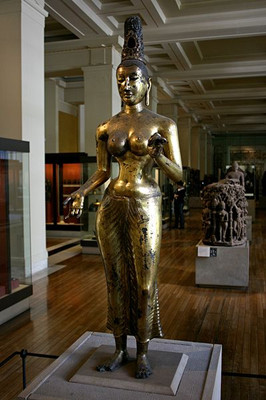The new faith spread rapidly along the trade routes of India. So that when this sculpture of Tara was made around 800 AD, Sri Lanka had been predominantly Buddhist for over a thousand years. The particular strand of Buddhism that flourished in Sri Lanka at this time gave a special place to divine beings called bodhisattvas, who could help the faithful live better lives. Tara is one of them.
新的信仰沿著印度的貿(mào)易路線迅速傳播開(kāi)來(lái),因而在這尊度母雕像完工之時(shí),佛教已作為斯里蘭卡的主要宗教存在了千年以上。在盛行于斯里蘭卡的眾佛教天人中,菩薩占據(jù)了重要位置,他們是能救信徒于苦難的神靈。度母便是其中之一。
Here's Professor Richard Gombrich, a leading expert on Buddhist history and thought:
佛教歷史與思想研究方面的權(quán)威理查德貢布里希教授這樣分析她的背景:
"Now, who exactly is this Buddhist image called Tara? She is a personification. She represents in person, symbolically, the power of a Buddha to save you, to take you across the ocean which is this world, into which, according to most Buddhists, you are continually reborn, until you find your way out. There is a particular future Buddha, a bodhisattva called Avalokiteshvara, and he is first found in texts which probably date from the first century AD. Initially he operates by himself, but after a few centuries the idea came that his power to save could be personified as a goddess. She represents his compassion and his power. Tara is simply an aspect of Avalokiteshvara."
她是一個(gè)化身,象征佛陀拯救眾生、渡人脫離輪回苦海的力量。有一位特殊的未來(lái)佛菩薩,叫觀世音,早在公元一世紀(jì)便有關(guān)于他的文字記錄。起初他以男神的形象度化眾人,但數(shù)百年后,他的救世力量逐漸以女神的形象來(lái)承載,她代表他的慈悲與無(wú)邊法力。度母便是觀世音的化身之一。
來(lái)源:可可英語(yǔ) http://www.ccdyzl.cn/Article/201512/413089.shtml











